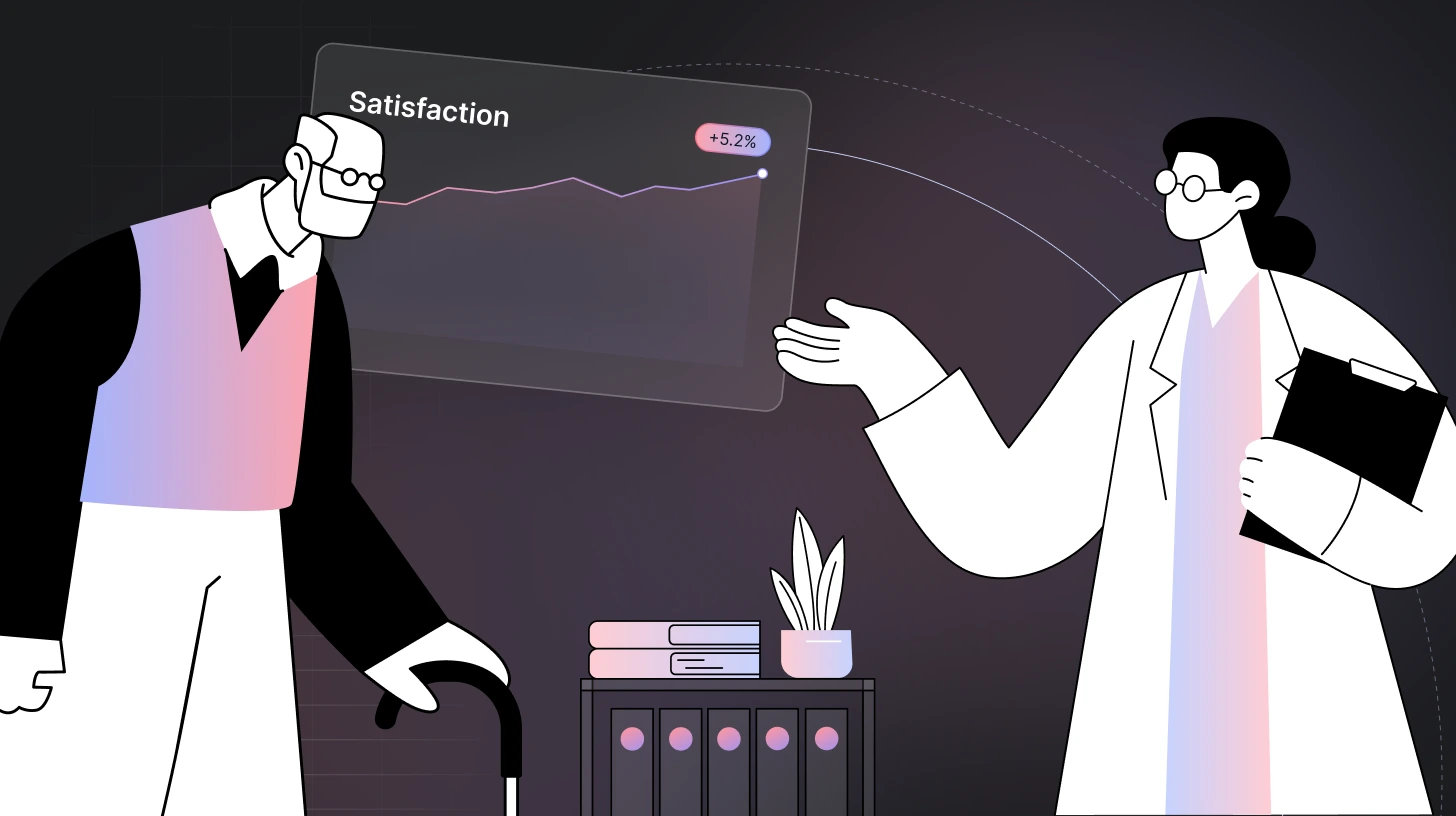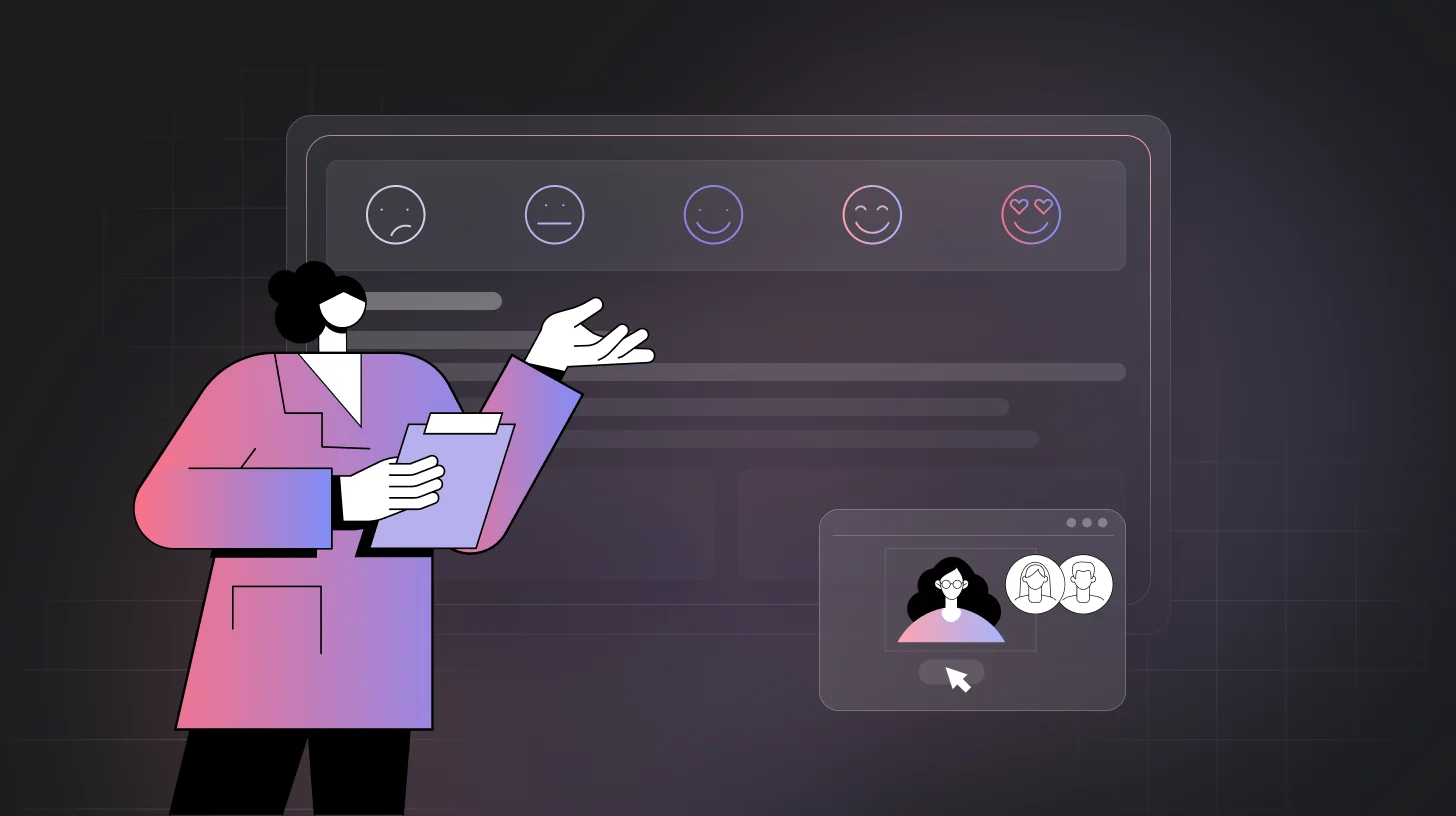 Blog
Blog Everything You Need to Know About Patient Surveys in 2025
Everything You Need to Know About Patient Surveys in 2025Everything You Need to Know About Patient Surveys in 2025

In healthcare and beyond, collecting and acting on feedback is key to delivering better and more personalized services. A well-designed patient survey does more than gather opinions; it uncovers the insights needed to provide safer, smarter, and truly patient-centered care.
Whether you're looking to improve satisfaction scores, identify gaps in patient experience, or support value-based care initiatives, surveys are your frontline tool for understanding what patients need directly from patients.
In this guide, I’ll break down everything you need to know about building a smarter patient survey strategy. Let’s get started!
TL;DR
- Patient surveys are essential tools to gather real, actionable feedback from patients about their care experience.
- They go beyond satisfaction scores; they help healthcare providers identify gaps, build trust, and improve services.
- Types of patient surveys include: satisfaction surveys, experience surveys, post-discharge follow-ups, treatment-specific surveys, and more.
- According to the Agency for Healthcare Research and Quality, 76% of patients say how they’re treated by staff is as important as the treatment itself.
- Using AI-powered tools like TheySaid, clinics and hospitals can collect more honest, in-the-moment feedback without long, boring forms.
What is a patient survey?
A patient survey is a simple but powerful way to gather feedback directly from patients after a healthcare visit. It helps clinics, hospitals, and private practices understand how patients felt about their experience, including communication and wait times, staff behavior, and overall satisfaction.
But here’s the real story behind it.
Imagine a patient walks out of your clinic nodding politely, but inside, they’re unsure. They didn’t quite understand the treatment plan. The nurse seemed rushed. The waiting room was loud. But they don’t say anything because most people don’t want to complain in person.
Now imagine you send them a quick, thoughtful patient feedback survey later that day.
They click a few buttons and leave a comment like:
“I felt a little lost after the visit. Can someone explain the next steps again?”
That’s it. But it’s everything.
You now have real insight without guessing or assumptions. You can follow up, fix the communication gap, and improve the experience for every patient who walks in after them.
With the right questions and the right timing, patient surveys help you:
- Identify problems before they become complaints
- Reduce readmission rates
- Increase patient satisfaction and loyalty
- Make smarter, data-driven decisions
Also Read: The Complete Guide to Patient Well-Being Surveys for Better Healthcare
Why Patient Surveys Matter (Backed by Stats)
1 in 3 patients switch providers due to a bad experience. According to a study by Accenture, 33% of patients left a healthcare provider because of a poor customer experience, even if the medical care was fine. Source
84% of patients say communication is the most important part of their experience. A survey by NRC Health found that communication ranked as the top driver of patient loyalty, even more than wait time or convenience. Source
Hospitals with strong patient feedback programs reduce readmissions by up to 40%. The Agency for Healthcare Research and Quality (AHRQ) shows that using patient feedback can lead to fewer avoidable readmissions, better medication adherence, and improved safety. Source
Patient-centered organizations perform better across the board. The Beryl Institute found that organizations prioritizing patient experience see higher clinical outcomes, staff satisfaction, and financial returns. Source
Most common types of Patient Surveys
Recommended read: Everything You Need to Know About Healthcare Surveys

Read - Patient Experience Surveys: Benefits, Questions, & Template
Top 8 Benefits of Patient Surveys in Modern Healthcare
Let’s take a look at how patient surveys can actually make a difference.
Better Patient Retention and Loyalty
People remember how they were treated, not just the treatment itself. Feeling heard keeps them coming back. A dental clinic noticed recurring complaints about rushed appointments. By adjusting scheduling to allow a few extra minutes per visit, repeat visits jumped by 18%.
Data-Driven Operational Improvements
Feedback helps identify what’s actually slowing down care or hurting the patient experience.
A clinic’s survey revealed that front-desk staff were inconsistent with appointment reminders. After introducing automated texts, no-show rates dropped by 22%.
Real-Time Decision Making with AI Tools
With AI, feedback is summarized and categorized instantly, so you’re not weeks behind on key issues. For example, TheySaid flagged a spike in “confusing billing” mentions in a specific region. The billing team responded in 24 hours, updating language and reducing patient calls by 40%.
Increased Staff Accountability and Morale
Feedback shows what’s working and what’s not without guessing. Teams can take pride in what they’re doing well and improve where needed. One hospital shared monthly patient comments with staff. Positive mentions of nurses increased morale, while mentions of poor communication led to targeted training sessions.
Personalized Patient Experiences
Every patient is different. Modern surveys adapt based on the journey, making feedback feel less like a form and more like a conversation. For Example, A cancer clinic used adaptive surveys to check in on mental health and fatigue during treatment. This led to quicker referrals to support services that patients were unaware of.
Stronger Brand Reputation
Today, patient reviews can make or break a healthcare brand. Surveys help fix problems before they become public. A pediatric clinic noticed lower ratings on Google. Their internal survey revealed long check-in times. After fixing that, reviews improved organically without extra marketing spend.
Faster Innovation Cycle
Great product ideas come straight from users, your patients. Surveys help you build faster and smarter. A healthtech company offering virtual therapy discovered through surveys that users wanted evening sessions. They piloted nighttime hours—and saw a 2x increase in usage.
Supports Value-Based Care Models
Value-based care rewards better outcomes and patient satisfaction rather than more services. For example, a primary care network used well-being surveys to monitor chronic care patients. Tracking quality-of-life metrics helped them boost scores in Medicare’s value-based care reporting.
How to Use Patient Surveys to Improve Healthcare
Different healthcare providers use patient surveys in unique ways, often based on their goals, team structure, and patient population. For some, surveys are used to navigate change, reduce inefficiencies, and improve their bottom line. Others, like community-focused health systems or behavioral care organizations, use surveys to collect experience data such as Net Promoter Score® (NPS), satisfaction levels, or patient well-being indicators.
But patient surveys aren’t just about collecting feedback from patients. Many providers also survey clinical staff, admin teams, and even caregivers to better understand the full ecosystem of healthcare delivery. When you improve employee experience, it reflects directly in patient care.
Here are just a few ways organizations are using surveys to drive real improvements across the board:
- Comply with accreditation and quality standards:
Surveys can be a simple way to collect the documentation needed for programs like CMS CAHPS or Joint Commission accreditation. - Measure and improve patient safety culture:
By surveying frontline staff anonymously, organizations can uncover issues in handoffs, reporting, or infection control, and then take steps to improve them. - Track healthcare employee engagement:
Engaged healthcare workers deliver better care. Internal surveys can help you identify burnout, training needs, or cultural gaps before they affect patients. - Centralize patient feedback in one platform:
Modern tools (like TheySaid) allow organizations to store and analyze survey data across touchpoints from intake to post-op, making it easier to spot trends and act quickly. - Streamline patient intake and history collection:
Digital forms and pre-visit surveys improve efficiency and reduce paperwork, while also giving providers better context before the visit even starts. - Benchmark satisfaction and loyalty metrics:
By tracking KPIs like NPS or CSAT across time and departments, healthcare teams can identify where they’re succeeding and where they’re slipping. - Conduct internal and external market research:
Whether it’s gauging how patients feel about a new service or seeing how you stack up against competitors, surveys can provide the data you need to make confident decisions.
Across all these use cases, patient surveys unlock powerful insights. With the right strategy and tools, they become more than feedback forms; they become drivers of better care, stronger teams, and measurable growth.
Read - 50+ Patient Satisfaction Survey Questions to Ask for Better Insights

Create your patient surveys with TheySaid
Patient surveys allow healthcare professionals and administrators to assess satisfaction, improve patient experiences, and deliver high-quality care.
TheySaid empowers organizations to go beyond traditional surveys with AI-powered conversations that surface deeper insights in less time. With customizable templates and smart summaries, it’s easy to collect meaningful feedback from patients, staff, and other stakeholders and turn it into real action.
Start listening smarter with TheySaid and improve the care you deliver every day.
FAQs
What is the purpose of a patient survey?
A patient survey helps healthcare providers understand how patients feel about their care experience, from wait times and communication to trust and satisfaction. It gives insights you can’t get from data alone.
How often should I conduct patient surveys?
Ideally, you should collect patient feedback after key touchpoints, like after appointments, procedures, or discharges. Regular surveys (monthly or quarterly) help you track changes over time.
Are patient surveys required for healthcare compliance?
While not always legally required, many accreditation bodies (like HCAHPS in the U.S.) strongly recommend or mandate standardized patient experience surveys.















.svg)